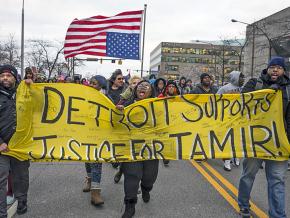A cop who should never work again
An Ohio town offered a job on its police force to the cop who killed 12-year-old Tamir Rice — but a public outcry was the key to stopping this outrage, writes .
TIMOTHY LOEHMANN was an officer with the Cleveland Police Department (CPD) when he shot and killed 12-year-old Black child Tamir Rice in 2014, a death which sparked national outrage over police racism and brutality.
Loehmann and his partner drove up to Tamir, who had a toy pellet gun, in a park. In less than two seconds — before the patrol car had even come to a stop — Loehmann jumped out of the car and fired on Tamir. Neither Loehmann nor his partner administered first aid to Tamir as he lay bleeding to death.
Loehmann, it was later discovered, had been forced to resign from his previous position in another town because he was found to lack the emotional stability to be a cop. In May of last year, it was announced that Loehmann had been fired by the CPD for not disclosing the reasons he was forced out of his previous job.
Neither Loehmann nor his partner faced any criminal penalties for the killing of Tamir Rice. Loehmann was cleared of charges by a Cuyahoga County grand jury and Cleveland’s Critical Incident Review Commission. The only stated reason he was fired from the CPD was for omitting employment information on his job application.

But while cops protect the interests of the ruling class — the elite and filthy rich, the politicians and CEOs — they also protect their own.
A résumé with murder experience didn’t leave Loehmann unemployed for long. In early October, it was discovered that Loehmann had been hired as a part-time officer with the Bellaire Police Department in southeastern Ohio. Bellaire Police Chief Dick Flanagan justified the hiring, telling WTOV:
He’s not quitting on being a police officer. He made a decision [in 2014] that’s going to stay with him the rest of his life. Like anybody else, if you make a mistake, someone’s got to give you a second chance, give someone opportunity. There is no worry, I stand behind this officer...I’ll stand behind this officer like I will any of my officers.
Tamir Rice, of course, never got a “second chance.”
The announcement of Loehmann’s hiring caused a visceral reaction of anger from community members. The Bellaire Police Department received more than 200 calls over a four-hour period.
After this public outcry, Loehmann announced he was turning down the new job offer, saying he “wanted to pursue the legal end of what’s going on...in Cleveland and...[didn’t] have the time to travel back and forth.”
TO ANYONE opposed to racism, the re-hiring of Loehmann is deplorable — but shouldn’t come as a surprise. The Black Lives Matter movement has exposed the way police departments will go to great lengths to protect their own, uphold their authority and discredit those who attempt to demand justice for victims of police brutality — a group in which Black and Indigenous people are disproportionately represented.
To understand the balance of forces that allow police departments to protect their own, offering jobs to murderers, racists and rapists, it’s important to point out what police exist to do.
Ultimately, “protecting the public is not the function that the police serve,” Richard Putz wrote at SocialistWorker.org. “The police are tasked with protecting the power and property of the wealthy and powerful.” Moreover, police officers often protect open white supremacists, including those with affiliations to neo-Nazi groups and the KKK — and officers sometimes have their own ties to these groups.
As the ruling class creates more disorder in the world through wars, cuts to public programs and attacks on the civil rights of workers, “it increasingly turns to a more conservative political agenda of ‘law and order,’ which it addresses with more guns, more powerful weaponry, more prison sentences, and more violence,” writes Sidney L. Harring in Policing: A Class Society.
Police brutality has long plagued working-class communities and communities of color. Instead of putting money into much-needed public service programs, like food pantries or health care, the ruling class has expanded the carceral system and beefed up police departments.
The ruling-class mission to clamp down on working-class living conditions and the rights of ordinary people can’t be successful if the general public begins to doubt the authority of police departments.
The institutional abuse of power by police departments knows few bounds. One Maryland police officer was recently charged with first- and second-degree rape, along with a slew of other charges, for raping a woman during a traffic stop.
Such abuse goes hand-in-hand with the institution of the police, whose job is to maintain order and consolidate their power by any means necessary. Violence and sexual assault become a normal outgrowth of that for some officers.
For the family of Tamir Rice, Loehmann’s job offer must come as a slap in the face. Though a wrongful death lawsuit by the Rice family was settled with the city of Cleveland for $6 million, those who have lost a loved one know that neither money nor any other material object is a replacement for a life lost.
In the case of Loehmann, it wasn’t until public pressure was applied that he was forced to turn down the opportunity to work as a cop again. It shows that such abuses of power will continue unless we ardently pursue our demands for justice.
Going forward, we will have to build movements capable of demanding that killer cops not be re-hired, that police rapists face the consequences of their actions, and that communities enduring injustice be able to live freely, without police intimidation and violence.


